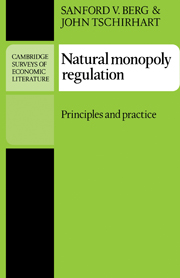Preface
Published online by Cambridge University Press: 06 November 2009
Summary
For nearly a quarter of a century, researchers have been responding to a series of path-breaking articles on the economics of public utilities. For example, Stigler and Friedland (1962) examined the effects of regulation on electricity prices, using data from the early 1900s. They found no impact on prices, and an outpouring of additional studies followed. Simultaneously, Averch and Johnson (1962) analyzed the impact of rate-base regulation on a firm's input mix and output. More elaborate models followed on the heels of their seminal contribution. At about the same time, Steiner (1957) and others were establishing the conditions for efficient pricing for a firm that experiences peak and off-peak demands for its output. The field of public utility economics no longer moved at a glacial pace, with case studies composing a substantial portion of its literature. Rather, it became part of the cutting edge of microeconomic theory, with more sophisticated analytical tools being applied to pricing and investment problems encountered in the context of natural monopolies.
Alfred E. Kahn's comprehensive textbook, The Economics of Regulation (1971), consolidated the extant literature, but the founding in 1970 of the Bell Journal of Economics contributed to the growth in the number of articles on utility topics. As an indication of that journal's impact, one need only note that this relative newcomer quickly became one of the top 10 economics journals. The sustainability of natural monopoly, nonlinear pricing, and regulation under uncertainty are just three of the themes stressed in this literature that have enriched our understanding of complex regulatory issues.
- Type
- Chapter
- Information
- Natural Monopoly RegulationPrinciples and Practice, pp. ix - xiiPublisher: Cambridge University PressPrint publication year: 1989
- 2
- Cited by



